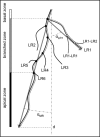EZ-Rhizo software: the gateway to root architecture analysis
- PMID: 19649192
- PMCID: PMC2637502
- DOI: 10.4161/psb.4.2.7763
EZ-Rhizo software: the gateway to root architecture analysis
Abstract
Plants are sessile organisms that have to cope with the available nutritional resources and environmental constraints in the place where they germinate. To fully exploit their nearby resources, they have evolved a highly plastic and responsive root system. Adaptations to limited nutrients include a wide range of specific root responses, e.g., the emergence of new root types, root branching or specific growth of lateral roots. These root system architecture (RSA) features are of utmost importance when investigating the underlying mechanisms by forward, reverse or quantitative genetic approaches. The EZ-Rhizo software was developed to facilitate such root measurements in a fast, simple and accurate way. The performances of EZ-Rhizo in providing about 20 primary and derived RSA parameters were illustrated by looking at natural variability across 23 Arabidopsis accessions. The different RSA profiles obtained from plants grown in favorable condition illustrated the wide reservoir of natural genetic resources underlying specific features of root growth. This diversity was used here to correlate the RSA genetic variability with growth, development and environmental properties of accession origins.
Keywords: Arabidopsis thaliana; image analysis; natural variation; root architecture; software.
Figures

Comment on
-
EZ-Rhizo: integrated software for the fast and accurate measurement of root system architecture.Plant J. 2009 Mar;57(5):945-56. doi: 10.1111/j.1365-313X.2008.03739.x. Epub 2008 Nov 4. Plant J. 2009. PMID: 19000163
References
-
- Malamy JE. Intrinsic and environmental response pathways that regulate root system architecture. Plant Cell Environm. 2005;28:67–77. - PubMed
-
- Osmont KS, Sibout R, Hardtke CS. Hidden branches: developments in root system architecture. Ann Rev Plant Biol. 2007;58:93–113. - PubMed
-
- Linkohr BI, Williamson LC, Fitter AH, Leyser HMO. Nitrate and phosphate availability and distribution have different effects on root system architecture of Arabidopsis. Plant J. 2002;29:751–760. - PubMed
-
- Stitt M, Feil R. Lateral root frequency decreases when nitrate accumulates in tobacco transformants with low nitrate reductase activity: consequences for the regulation of biomass partitioning between shoots and root. Plant and Soil. 1999;215:143–153.
Publication types
LinkOut - more resources
Full Text Sources
